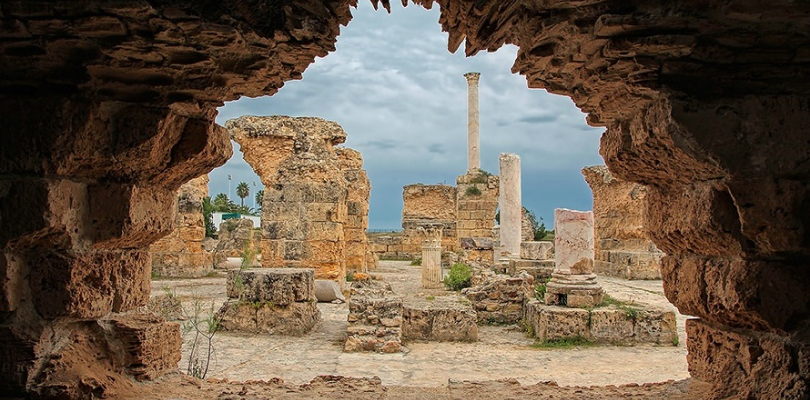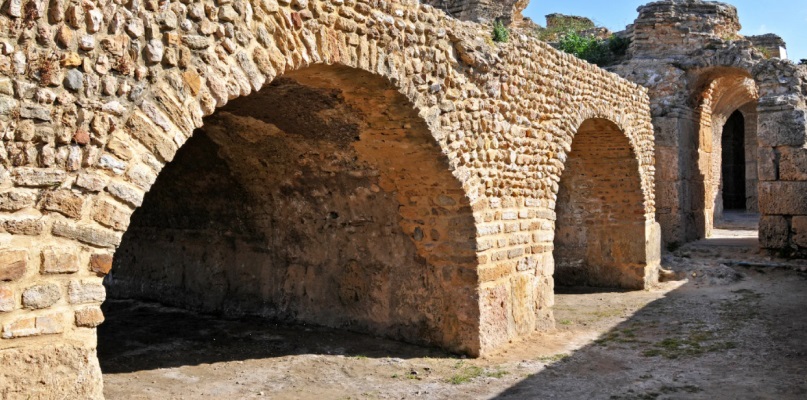Baths of Antoninus in Carthage
Visiting historical sites, even ruins, can give an idea not only of the scale of the city that once was here, but also of the daily life of the people who inhabited it. Such a witness of time in Carthage was the baths of Anthoninus Pius, which can tell about the life of Romans here during the heyday of the Empire.
The baths are located on the shore of the Gulf of Tunis and occupy an impressive area. Today they are included in the UNESCO World Heritage List and are the attraction which is usually referred to as a “must see” one.

Baths were Romans’ favorite place to enjoy their pastime
In the Roman Empire baths, or thermae, were an important building in every major city, and, of course, Carthage – the center of the province of Africa – was one of them. Thermae are public baths, visiting which was an indispensable part of lives of Roman citizens. And not only citizens, but also slaves.
However, these buildings were intended not only for washing, but also for meetings, sociolizing and sports exercises, even gardens for short walks and libraries were constructed there. Visiting the baths was one of the common daily activities of the Romans.
As a rule, there were several entrances to the baths: for men, for women and for slaves. Wealthy people often had their own private baths, but they still visited public ones in order to participate in the life of the city and communicate with other people of their circle. Most often, they met in thermae. Men and women, the elderly and the young, the rich and the poor, free people and slaves – all visited the baths.
Large thermae were built by order of the emperors or in their honor. These were majestic complexes, the rooms in which were decorated with mosaics, sculptural compositions and marble. For the emperors such constructions were one of the ways to immortalize and glorify their names. Another reason is that the emperors were venerated as gods. Thus, the baths in Carthage were named after the emperor Antoninus Pius, who then ruled the Empire.
The baths were supplied with huge amounts of water by an aqueduct which was built after the Romans had discovered fresh water resources in mountains of the Tunisian Atlas.
There was a special heating system in the thermae, which made it possible to build heated floors and walls, hot water pools, steam rooms. Slaves were engaged in heating and servicing the furnaces: they had to spend hours in the heat, and even under the scorching sun, so that the baths did not stop working. The furnaces were, as a rule, outside the thermae, and hot water got inside through a special pipe system.

There were hot rooms for relaxation in thermae, from where you could go to warm rooms and enjoy a massage with oils, and to get cool, there were also special rooms called frigidaria.
In the center of the baths there was a palaestra – an inner courtyard where gymnastics classes were usually held, a garden for walks, and sometimes a swimming pool. So, the Romans turned ablutions and bathing into a whole art, and the baths became the center of social life in the Empire. As a rule, visiting the baths was free.
Baths of Antoninus is an important archaeological find
The baths of Antoninus Pius are the largest baths in Africa and almost the largest in the entire Roman Empire at the time of their construction, which took place in the middle of the 2nd century AD. Only the baths of Caracalla and Diocletian, which were built later, are bigger than the baths of Antoninus in Carthage.
The construction of thermae was started by the order of emperor Antoninus Pius after a huge fire in Carthage, which destroyed most of the city, to calm down and distract people from sad thoughts and experiences.

What did the baths of Antoninus Pius look like?
Once the baths were an impressive structure with a height of about 40 meters and a length of more than 200. The total area of the thermae complex was approximately 35 thousand square meters.
The size of the baths can be estimated by the column, which has been restored and it is located right in the center of the ruins, so that visitors can imagine how majestic the building was. Once this column supported the arches of the frigidarium.
The baths were a symmetrical building, divided into two parts — male and female. From the baths there was a magnificent descent to the sea, on the shore of which the baths were located. The terraces offered a beautiful view of the bay. By the way, when the sea level rose, some of the buildings were flooded, which also led to their destruction.
There were many rooms inside the baths of Antoninus Pius, as can be seen from the layout restored by archaeologists:

Historians suggest that noble citizens in Carthage tried to settle closer to the thermae, as life was in full swing there: political affairs were discussed, trade deals were made, and people constantly exchanged information.
What has been preserved from the baths of Antoninus Pius?
Unfortunately, the locals began to use parts of the baths, when their destruction started, for the construction of their own houses, and this is why the once majestic building is so poorly preserved. Parts of the thermae were even shipped to Pisa, Genoa and the suburbs of London.
Nowadays tourists can wander only through the remains of underground structures, where servants’ quarters, plumbing and heating mechanisms were located. These remnants of the building look like a maze with many rooms and corridors.
The remains of the baths were discovered by the French at the end of the 19th century, but excavations began only in the middle of the 20th century. Then fragments of columns made of marble, granite, porphyry, facing elements and fragments of mosaics were found among the ruins. The baths also contained marble images of emperor Antoninus Pius with his wife and daughter.



 05.05.2025
05.05.2025